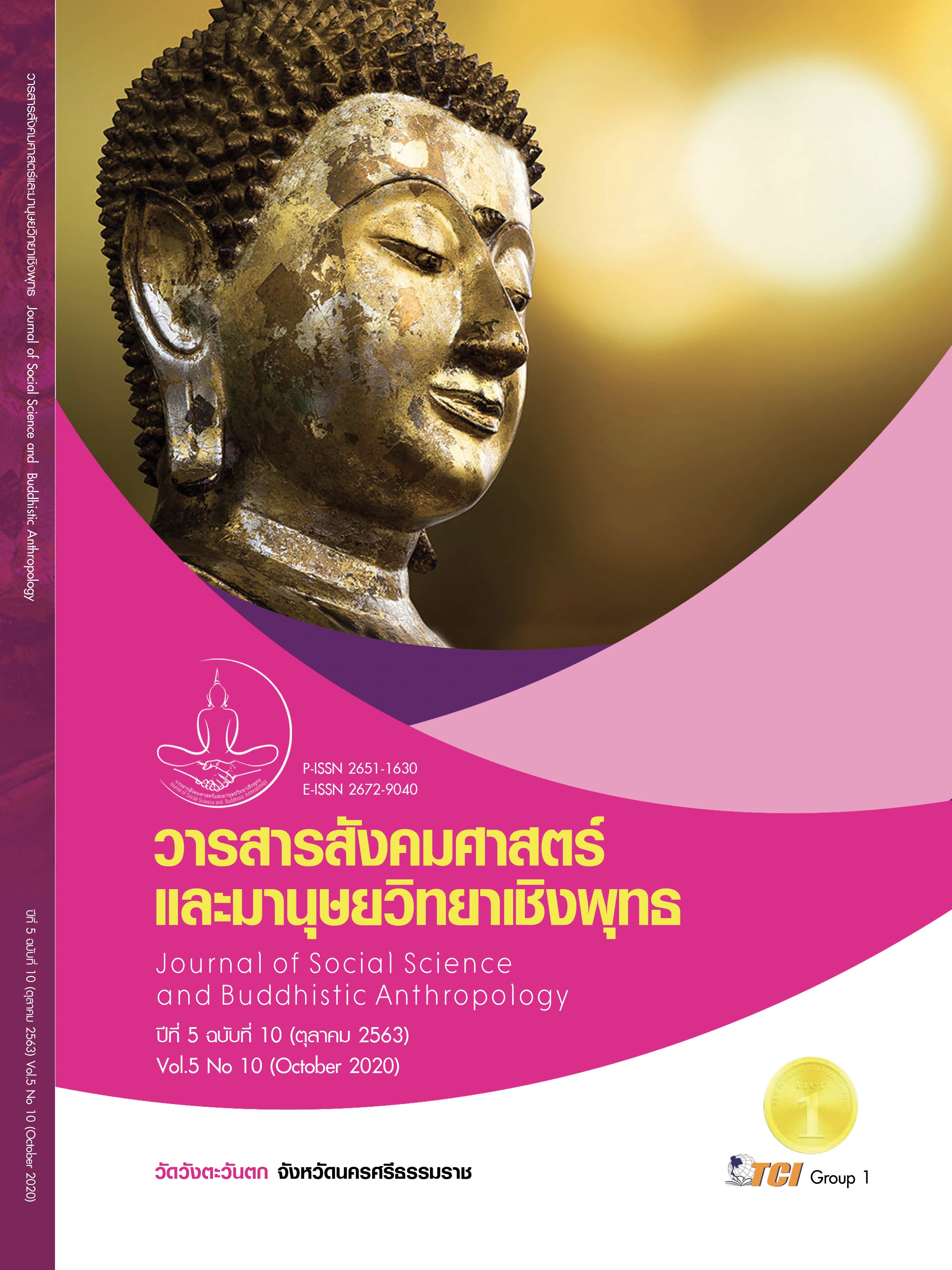THE DEVELOPMENT OF INHERIT CHANTABOON FOOD WISDOM MODEL BY USING CLOUD COMPUTING TECHNOLOGY AND SOCIAL MEDIA BASED ON SUFFICIENCY ECONOMY CONCEPT TOWARDS CREATIVE ECONOMY
Keywords:
Chanthaboon Food Wisdom, Cloud Computing, Social Media, Sufficiency Economy, Creative EconomyAbstract
This research article aimed to: 1) to study of the condition to inherit Chanthaboon food wisdom; 2) to develop of inherit Chantaboon food wisdom model by using cloud computing technology and social media based on sufficiency economy concept; 3) to study the results and propose the inherit Chantaboon food wisdom model. The samples determined by the Taro Yamane’s sample size and the multi-stage sampling consisted from inno - life communities, community enterprise and the farmers women groups in Chanthaburi Province. The sample groups consisted of: the first phase was 398 samples; the second phase 20 samples and in the third phase 30 samples. Data were analyzed by using mean, standard deviation, t-test and content analysis. The results are shown as follows: 1) The current situation of the condition to inherit Chanthaboon food wisdom found that highest transfer is the storytelling to children and intimate friend by in the moderate level. ( = 2.94, S.D. = 1.20). In the overall level of the condition to inherit Chanthaboon food wisdom is at a low level (
= 1.75, S.D. = 0.21). 2) The effective model development consisted of 6 components as follows: I-Proud Model (I: Introduction Idea, P: Proud of character inspiration to idea, Real - World Experiment and creating based on sufficiency economy concept; Open mind and sharing opportunities; User Interface (UI) User Experience (UX); Direct communication on the Internet). 3) The inherit skills in Chanthaboon food wisdom by using cloud computing technology and social media based on sufficiency economy concept towards creative economy of the sample groups were statistically higher than those before research participant project at the .05 level of significance. The experimental group had “highest level” positive satisfaction toward the model. The specialists confirm the model most overall appropriate.
References
กระทรวงเทคโนโลยีสารสนเทศและการสื่อสาร. (2559). แผนพัฒนาดิจิทัลเพื่อเศรษฐกิจและสังคม. กรุงเทพมหานคร: กระทรวงเทคโนโลยีสารสนเทศและการสื่อสาร.
ชรีย์พร ภูมา. (2553). การพัฒนารูปแบบยูเลิร์นนิ่งโดยใช้แนวคิดการแลกเปลี่ยนเรียนรู้ของชุมชนนักปฏิบัติและการเรียนรู้แบบโครงการเป็นฐานเพื่อสร้างนวัตกรรมเทคโนโลยีวัสดุศาสตร์สำหรับผู้ประกอบการวิสาหกิจ ขนาดกลางและขนาดย่อม. ใน ดุษฎีนิพนธ์ครุศาสตรดุษฎีบัณฑิต สาขาวิชาเทคโนโลยีและสื่อสารการศึกษา. จุฬาลงกรณ์มหาวิทยาลัย.
ธานินทร์ ศิลป์จารุ. (2557). การวิจัยและวิเคราะห์ข้อมูลทางสถิติด้วย SPSS และ AMOS (พิมพ์ครั้งที่ 15). กรุงเทพมหานคร: ห้างหุ้นส่วนสามัญบิสซิเนสอาร์แอนด์ดี.
ธีรยุทธ เสนีวงศ์ ณ อยุธยา. (2559). การถ่ายทอดภูมิปัญญาของผู้สูงอายุ. เรียกใช้เมื่อ 15 สิงหาคม 2560 จาก http://www.stou.ac.th/stoukc/elder/main1_12.html
พรทิพย์ ติลกานันท์. (2557). การนำเสนอรูปแบบการเรียนรู้ของชุมชนเพื่อเสริมสร้างความมั่นคงทางอาหาร. ใน ดุษฎีนิพนธ์ครุศาสตรดุษฎีบัณฑิต สาขาวิชาพัฒนศึกษา. จุฬาลงกรณ์มหาวิทยาลัย.
พิริยะ ผลพิรุฬห์. (2556). เศรษฐกิจสร้างสรรค์กับการพัฒนาประเทศไทย. วารสารเศรษฐศาสตร์ปริทรรศน์ สถาบันพัฒนศาสตร์, 7(1), 1 - 69.
สำนักงานจังหวัดจันทบุรี. (2560). แผนพัฒนาจังหวัด 4 ปี (พ.ศ.2561 - 2564) (ฉบับแก้ไข). จันทบุรี: กลุ่มงานยุทธศาสตร์และข้อมูลเพื่อการพัฒนาจังหวัด.
สำนักงานเลขาธิการสภาการศึกษา. (2560). แผนการศึกษาแห่งชาติ พ.ศ. 2560 - 2579. กรุงเทพมหานคร: บริษัท พริกหวานกราฟฟิค จำกัด.
สำนักพัฒนาธุรกรรมทางอิเล็กทรอนิกส์. (2562). รายงานผลการสำรวจพฤติกรรมผู้ใช้อินเทอร์เน็ตในประเทศไทย ปี 2562. กรุงเทพมหานคร: กระทรวงดิจิทัลเพื่อเศรษฐกิจและสังคม.
สุเมธ ตันติเวชกุล. (2559). ตามรอยพระยุคลบาทครูแห่งแผ่นดิน (พิมพ์ครั้งที่ 3). กรุงเทพมหานคร: สำนักพิมพ์แห่งจุฬาลงกรณ์มหาวิทยาลัย.
อมรรัตน์ อนันต์วราพงษ์. (2560). หลักการวิจัยเพื่อพัฒนาผลิตภัณฑ์ภูมิปัญญาไทย. กรุงเทพมหานคร: สำนักพิมพ์แห่งจุฬาลงกรณ์มหาวิทยาลัย.
อัธยานันท์ จิตรโรจนรักษ์. (2557). แนวทางการสืบสานคุณค่าของอัตลักษณ์สถาปัตยกรรมไทย. ใน ดุษฎีนิพนธ์ครุศาสตรดุษฎีบัณฑิต สาขาวิชาพัฒนศึกษา. จุฬาลงกรณ์มหาวิทยาลัย.
อินทิรา วิทยสมบูรณ์. (2554). รักษ์สืบสาน: การจัดการเรียนรู้ตามแนวทางสืบสานภูมิปัญญา. กรุงเทพมหานคร: บริษัท ที คิว พี จำกัด.
อุทิศ บำรุงชีพ และคณะ. (2560). การพัฒนารูปแบบการใช้ไอซีทีของผู้สูงอายุด้วยเทคนิคการเล่าเรื่องแบบดิจิทัลเพื่อสืบทอดภูมิปัญญาอาหารจันทบูร. ใน รายงานวิจัยฉบับสมบูรณ์. ชลบุรี: มหาวิทยาลัยบูรพา.
Low, C. et al. (2011). Understanding the determinants of cloud computing adoption. Industrial Management & Data Systems, 111(7), 1006 - 1023.
Michael, D. (2012). Social Media: An Introduction. Ottawa: The Library of Parliament of Canada.
Rogers, Everett M. (2003). Diffusion of innovations. USA: A Division of Macmillan Publishing Co., Inc.
Yamane, T. (1973). Statistics: An Introductory Analysis (Third editio). New york: Harper and Row Publication.








